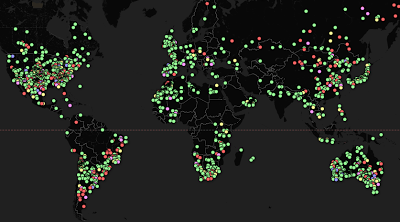Many moons ago, I wrote a post about meteors, meteor-showers and what to do in case you find a meteorite; it will be interesting to see where the material from all the ado in Russia winds up!
In case you've missed the action, a 10-ton former-asteroid-turned-meteoroid became a meteor in Earth's atmosphere over the Chelyabinsk oblast, exploding with 470 kilotons of force, shockwave-shattering about a million square feet of glass windows, and injuring 1200 people.
The Russian Academy of Sciences says the meteor entered Earth's atmosphere at a speed of at least 54,000 kilometers per hour, occurring just hours before Asteroid 2012 DA14 passed closely, between Earth and some orbiting satellites. Many have posited the two are related, but NASA data shows completely different trajectories. Put down the tinfoil hat!
метеорита, or "meteorita", pieces of which are now being sought by land hunters and divers near a Lake Tchebarkul in the Urals, was believed to have been more than 50-feet wide and weighed as much as the Eiffel Tower before impact. Thus far, no materials have been recovered from the water, though one imagines this new regional hobby will only pick up steam, and grow easier as the weather warms -- since it's become obvious now that any meteorite fragments will be worth thousands of dollars. Sadly, however, the damage from the sonic boom is already being estimated at well over 30 million, and climbing.
In the wake of all the spacey news following these events, the UK's Guardian Newspaper published an intriguing, clickable map about all the meteorite "falls" on Earth. Of course, this is a bit misleading, since we cannot possible ever know that. What they meant to say was "All the meteorites that have been catalogued, either by watching the fall of finding the craters, since the human species decided what the definition of a meteorite was."
A friend of a friend on Facebook commented on the map: "What do you think the distribution tells us? More seem to land in the USA, not so many in Africa. Interesting message in there somewhere."
However, there isn't a message, and I hope the Guardian clears this up (but judging from journalistic levels of science-savvy thus far, I'm not precisely holding my breath).
Distribution is actually plentiful all over the Earth; I think we merely see more in the USA on THIS map because this nation has a high level of detection technology, a history of scientific record-keeping, and ample individuals & teams who actually hunt around for craters and materials from meteorite impacts. In remote areas of the world where no one witnesses them, or where no one can gather the debris before they are buried in strata, fewer are recorded. Doesn't mean there weren't many, many hits that simply went unnoticed by humanity.
We also don't have ways of easily recording those that hit the ocean water and sink. If we did, the map would, of course, be far more full. This gives an insight into why the Moon or Mercury or other terrestrial bodies look the way they do! Lots of impact craters everywhere, showing that little things crash into big things all the time! Unlike other planets, however, Earth can cover her craters over time with water, sand, ice, plants, trees, etc. as weather, volcanoes, erosion, ecological succession, and plate tectonics trundle along.
Neil DeGrasse Tyson is pretty good at setting people straight... glad so many channels called upon him and Bill Nye the Science Guy to answer questions. Hopefully, they will eventually get to this collective one!





































































